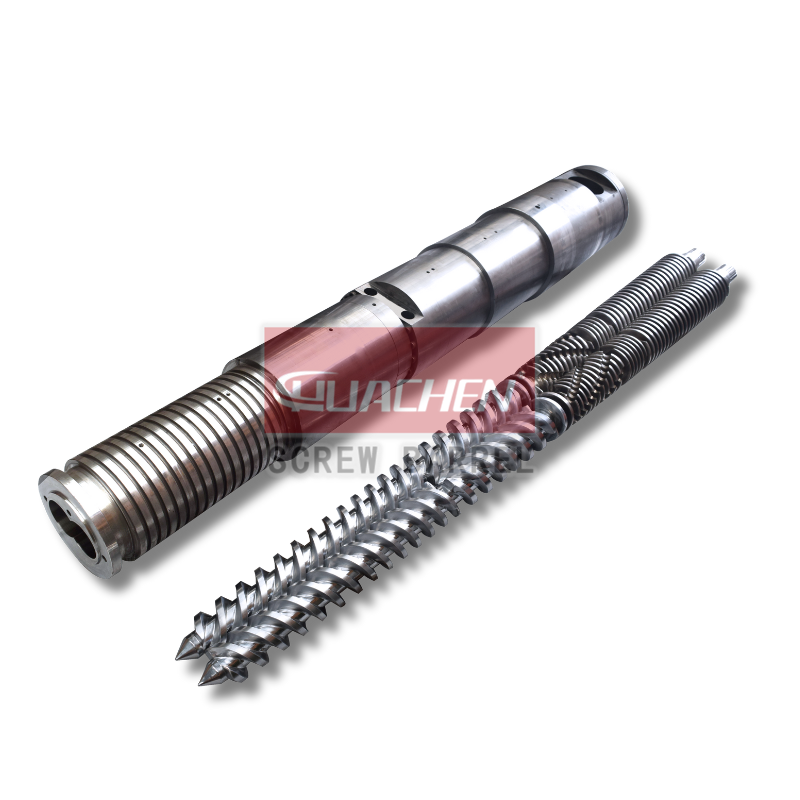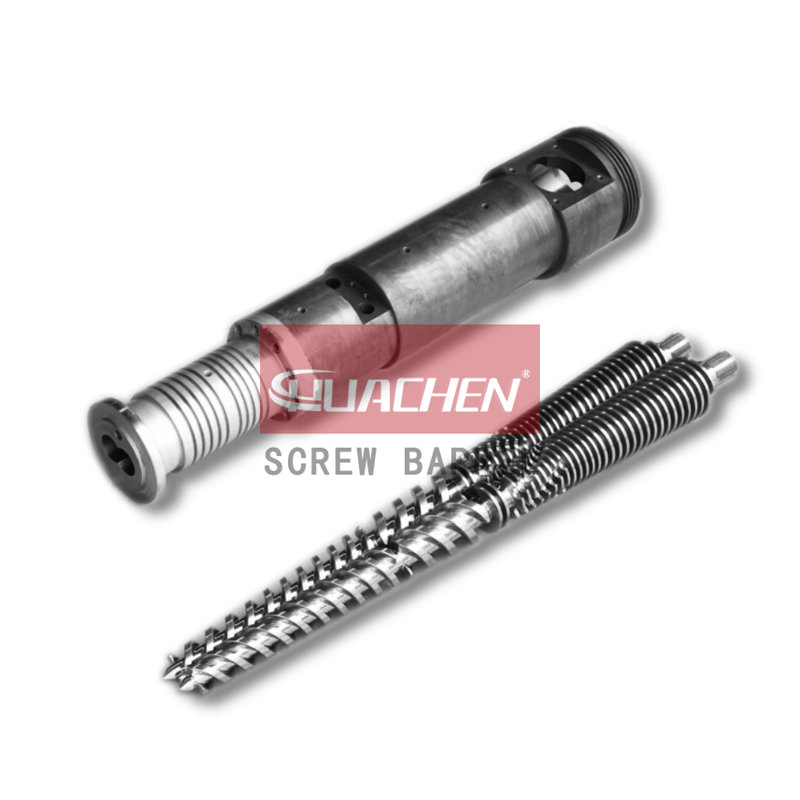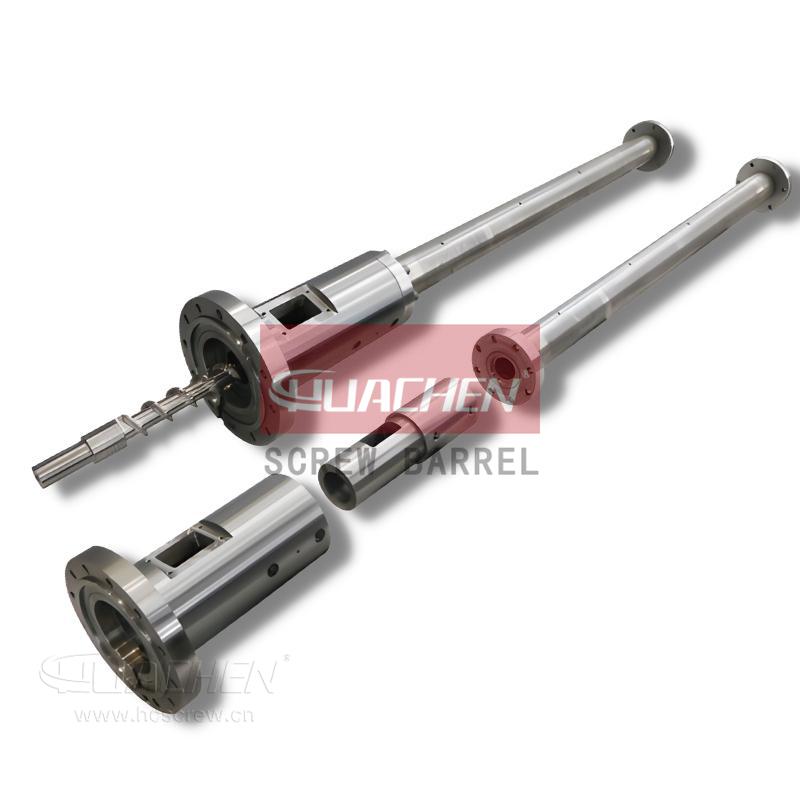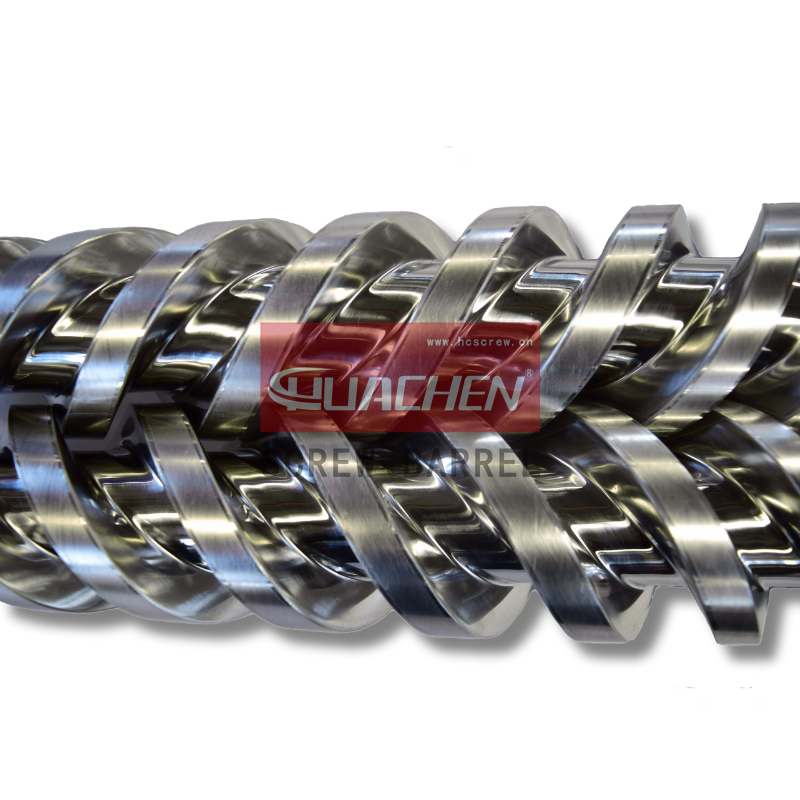How to Set Your Conical Twin Screw Barrel Temperature to Produce PVC?
Date:2022-12-11 Author:hcscrew
Conical twin screw extruders are the main machines for making rigid PVC products. The barrel of the extruder needs to be heated by an external heat element to work. We do this to melt the material inside the barrel from the outside. That’s so that the screw can work properly and plasticize the blended material. Screw barrel temperature affects both PVC extrusion quality and screw barrel life, so it’s very important. Here’s how to set those conical twin screw barrels to make PVC from HUACHEN Screw.
01 Conical twin screw barrel temperature setting elements
The entire UPVC extrusion production process with a conical twin screw extruder can roughly be divided into three areas: heating, thermostat and insulation. Heating and thermoregulation are mostly in the conical twin screw barrel. With the barrel venting port as the boundary, divided into two relatively independent and related parts. The insulation zone is created by the core confluence, the extrusion die head, and the extrusion outlet die and other components.
In the UPVC extrusion process, there are two sources of heat: one is the external heat provided by the extruder heater element, and the other is the heating inside the extruder. The UPVC material is generated by two factors: internal heat from shearing force, calendering, and friction, as well as friction between the UPVC materials. Each heat source plays a different role in different sections. The extruder’s temperature control only controls external heat. Almost all extruders can heat die head parts without internal heat (some die head with extra conventional design parameters can, too).
Compression, with internal heat and strong shear force, but not yet beyond the plasticisation requirements of the material, and melt, which is mainly for venting, are also relatively stable and easy to control. Shear force is relatively weak, relying mostly on external heating elements, but external heating isn’t enough for material plasticisation in the feed section (especially in extruders with low external heating power). It’s also common for the temperature control device to not work in the mixing section where shear force heat has exceeded plasticization requirements. As a result, the feeding and metering sections are the key points and most difficult parts of temperature control in the whole extrusion process.
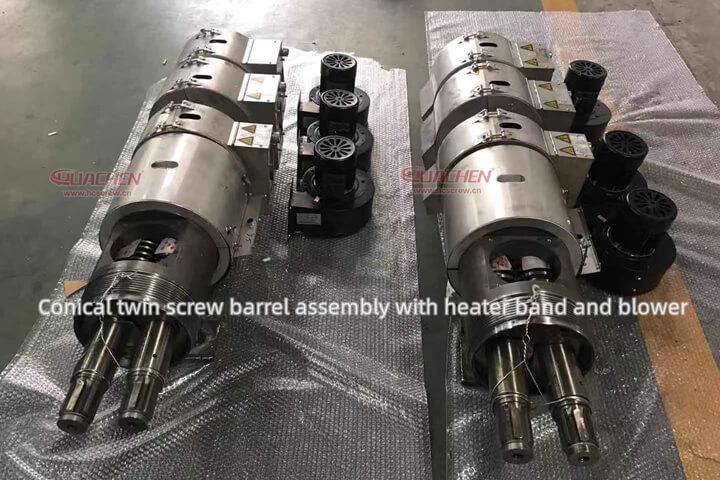
02 Temperature setting principle and focus of each section
1. conical screw barrel feed section temperature
The feed section is the heater that transfers heat to the barrel, the displayed temperature is the barrel temperature, not the material temperature. Material temperatures are often lower than displayed temperatures. By the time material passes through the screw feeding section into the extruder, the temperature is only about 30 °C-40 °C, and the temperature rise generated by the screw from the plasticizing temperature also has a large gap.
Through the compression section, the materials will pass through the barrel venting port. However, to complete the process of transforming from glassy to viscous flow state, the heated area requires basic orange peel. No powder material exists, and it must be tightly covered in the screw trough, so it does not obstruct the barrel venting port. Therefore, the feed section provides external heating. It’s best to set the temperature high. In this way, the heater band can provide the material with enough external heat.
During this time, the heater band opens and closes more frequently. As the material is fed to the feed section, from the die head extrusion there is still a period of time, plus to keep the material from sticking to the feeding mouth “bridge” or the machine “sticky wall”, the temperature should not be too high, about 185 °C is appropriate.
It’s still possible to produce products with intrinsic quality even at a lower temperature, like around 170°C or even lower. It’s hard to raise the melt temperature too much if you rely on shear heat from the screw barrel operation due to the low supply of external heat. It wears and tears the screw barrel and can affect the extruder screw barrel’s service life, but it’s worth it. When the extrusion temperature is too low, the screw compression section and metering section of the screw shear will be relatively strong and intensify wear and tear. As a result, the PVC extrusion process will produce yellow lines, black lines, or even equipment noise.
2. conical screw barrel compression section temperature
The material in the compression section of the larger shear force, the screw shear force, heats up faster. Set the temperature higher to help reduce the viscosity of the material, to speed up the flow, the same as the feed section. This will reduce the harm of shear heat.
Melt section temperature: When the screw groove volume changes (generally less than one compression ratio), the melt pressure suddenly reduces, playing the role of a thermostat and venting. Keep the compression section at the same temperature or a bit higher. The reduced melt pressure will reduce the material’s temperature, preventing melt cooling.
3. conical screw barrel metering section temperature
Metering section temperature isn’t material temperature. Shear heat just transfers material temperature to the screw barrel, and the material temperature is usually higher. The purpose of setting the temperature is not to provide external heat, but primarily to stop external warming. Using a screw barrel cooling device and adjusting the screw oil temperature appropriately will help transfer excess heat and prevent material degradation. As soon as the equipment is switched on, you will see that some cooling devices in this section of the screw barrel with severe wear and tear are barely keeping the temperature from rising. It’s recommended not to set the temperature too high, so 185°C is good. Low display temperatures happen when the extrusion volume is small. You might be able to get more shear by raising the screw barrel, screw set temperature, or feed speed.
4. Extueder core confluence temperature
When the melt has completely melted, it transitions from variable speed and variable pressure spiral movement to uniform linear motion. Through the die head, melt pressure is established so that the temperature, viscosity and flow rate are more uniform. This is in preparation for final moulding. In order to slow down the heat loss of the material, it’s best to set the core confluence temperature higher. When the set temperature is less than the material temperature, not only is the material not heated, but it also cools.
After the metering section, the actual melt temperature is higher than what’s displayed. If the displayed temperature is around 185°C, then the material temperature is above 190°C. There’s no reason to set the melting point of the core and mould at different temperatures to heat the melt. Rather, it prevents it from being dissipated due to the low temperature of the core confluence and the mould. It’s also easier to regulate the melt section’s flow rate with a higher core confluence temperature.
5. Twin screw temperature
There are two devices for screw temperature control: one is the screw self-regulating temperature, which works with the heat pipe convection principle, which means heat exchange occurs using the screw internal balance without any extra energy, but it’s not very efficient at transmitting heat. China’s popular twin screw extruders, currently the type SZ55/110, have this configuration. There’s an external heating and cooling unit that controls the twin screw’s constant temperature zones. Heating and thermostatic zones set the screw temperature based on the difference between set and displayed temperatures. It assists in heating or cooling the feed section in order to balance temperature differences between it and the metering section.
03 Temperature settings for each extrusion process tips
Feed section: 185 °C, depending on extruder shear performance and extrusion volume, to make sure display temperature is above 180 °C. Compression section: 180 ℃. Melt section: 180 ℃. Metering section: 170 ℃ – 180 ℃, according to the extruder shear performance and the extrusion volume, to ensure that the display temperature ≤ 185 ℃. It’s possible to adjust the screw temperature and feed rate separately if needed. Above content is for reference only, please refer to the actual situation.
Summary of screw barrel temperature setting
Although the conical twin screw barrel design principle differs between different extruder models and different products, most follow the “inverted V saddle-shaped” temperature settings: the barrel zone and the head temperature is the highest, about 200 degrees, while the merging core temperature is the lowest, about 170 degrees. When adjusting the screw barrel temperature, start at the lowest point. Increase the temperature every 5 degrees Celsius until you find the right one.
By setting the extrusion temperature to be “saddle type”, we make sure both the melting temperature and the material temperature are “step type”, always rising, and not because the temperature in the heating area is too low. The material isn’t fully plasticized, and it bubbles up. If the temperature is too high, the material degrades. No matter how hard the screw shears and how big the extrusion volume is, the extrusion process temperature setting should be basically the same. This is to ensure the quality of extruded products through plasticization, to reduce wear and tear on the screw barrel and to extend its lifetime.
About the twin screw barrel Factory: HUACHEN
HUACHEN Screw has been a leading conical twin screw barrel manufacturer in Zhoushan Jintang since 1993. As one of the leading companies in designing and processing parallel and conical twin screw extrusion screw barrel, HUACHEN Screw can provide its customers with a wide range of services, including drawing rebuilding, design, modification, and customized screw barrels. Our company has also successfully exported and supplied screw barrels to customers worldwide.
>>Learn more about our company
You May Also Like
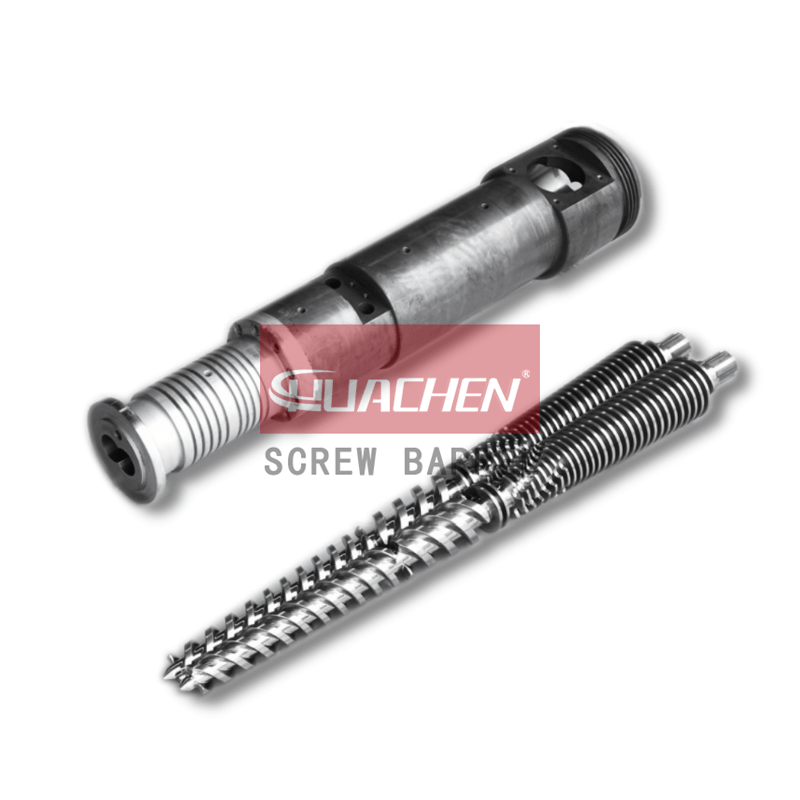 | PVC Pipe Conical Twin Screw Barrel ↗ Get PVC pipe conical twin screw barrel details and prices from HUACHEN screw barrel factory. Good plasticisation, heavy duty screw barrel. |
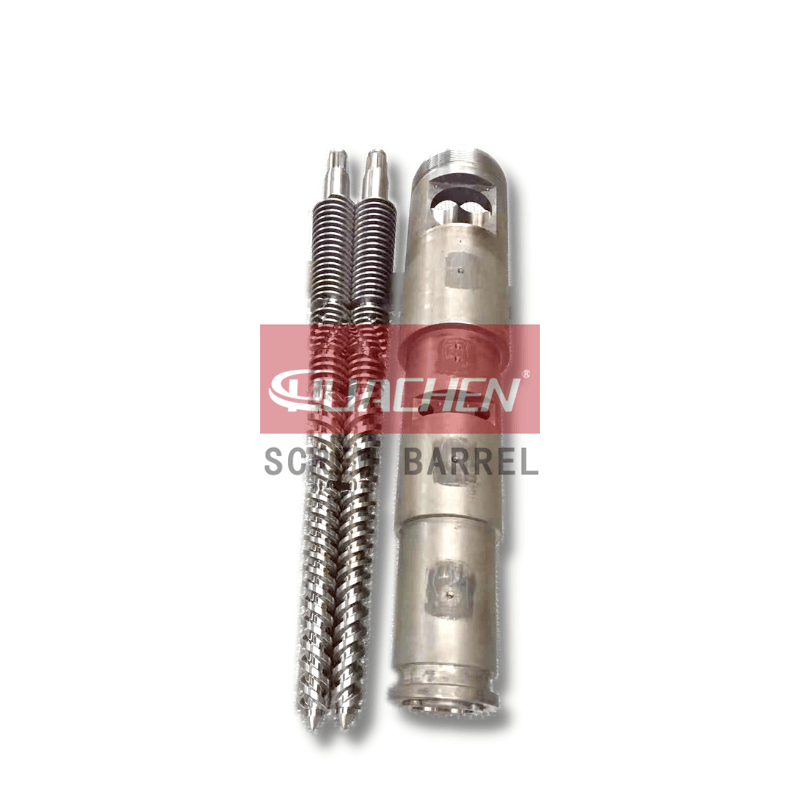 | PVC Profile Conical Twin Screw Barrel ↗ Get details and price of PVC profile conical twin screw barrel. Better PVC profile twin screw barrel for PVC window door profiles at HUACHEN. |
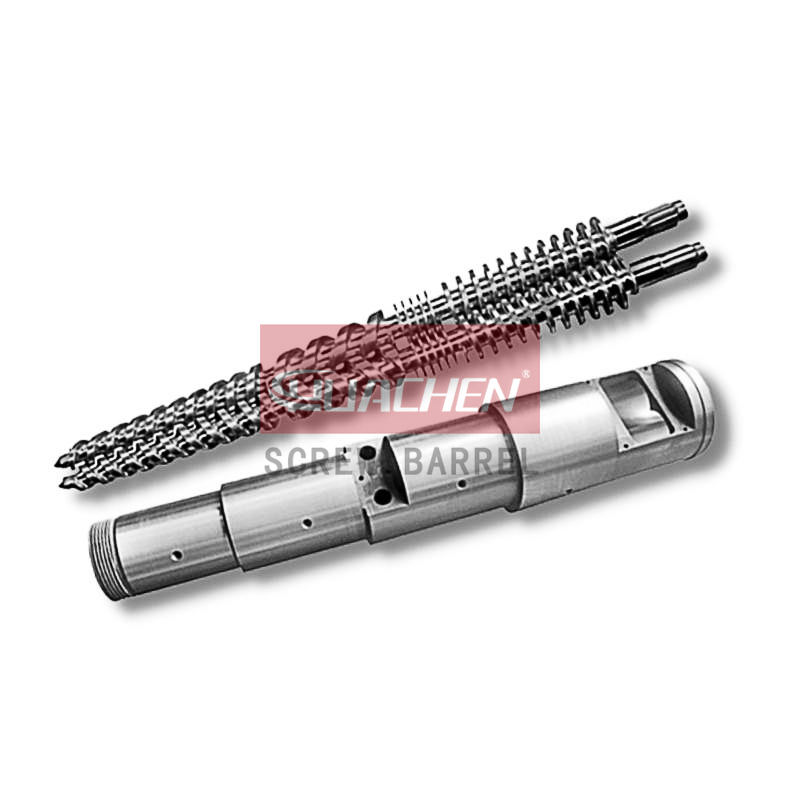 | Conical Twin Screw Barrel ↗ Get latest & most competitive prices on China conical twin screw barrel, extruder barrels, extruder screw, bimetallic screw, SKD barrels… |
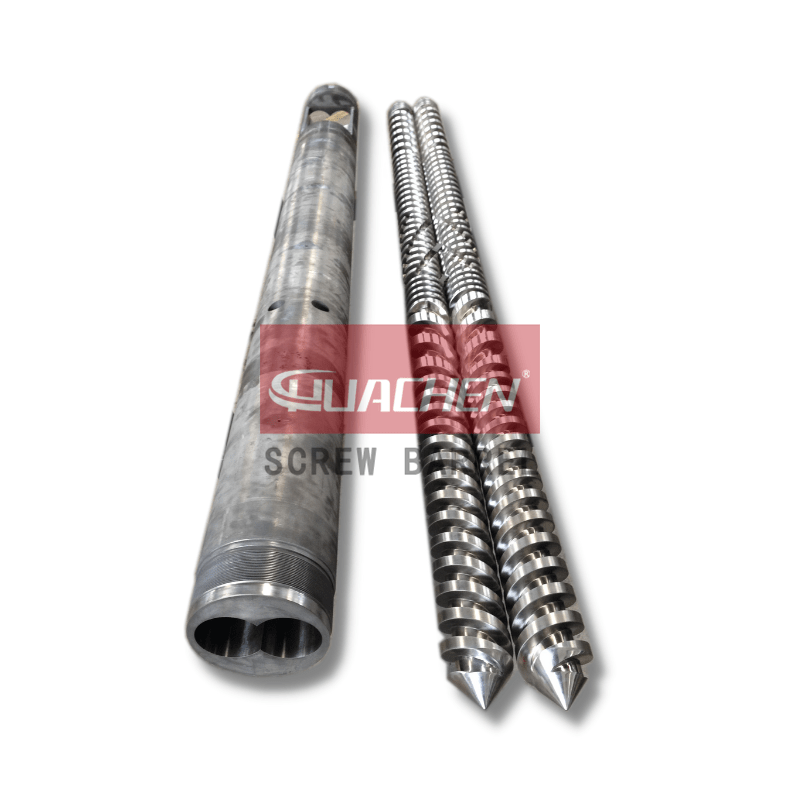 | Twin Screw Barrel ↗ Get latest good prices on China twin screw barrel, parallel conical twin screw barrel. Advantages, comparisons, materials, models… |
TAGS
HUACHEN Screw barrel recent post
- High-performance PVC Screw Barrel for Efficient Extrusion
- Durable Conical Twin Screw Barrel for Precision PVC Pipe Production
- High-Speed Screw Barrel for Increased Extrusion Efficiency
- Super Wear-Resistant Bimetallic Alloy Coating Screw Barrel for High Output Extruders
- High-Precision Parallel Twin Screw Barrel for Extrusion Excellence
- Top Quality Single Screw Barrels for Plastic Extrusion Applications
- High-quality Extruder Screw Barrel for Reliable Performance
- Efficient Plastic Extrusion Screw Barrel for Superior Output
conical twin screw barrel extruder screw barrel extrusion screw barrel Foam sheet processing high speed screw barrel HUACHEN SCREW news injection screw barrel parallel twin screw barrel pa screw barrel pe making formula pe screw barrel plastic fiber processing plastic fibre screw barrel Plastic film making screw barrel plastic pipe processing Plastic profile processing Plastic raw material knowledge pp screw barrel PVC making formula pvc screw barrel related parts for screw barrel screw barrel engineering work screw barrel knowledge single screw barrel twin screw barrel
;